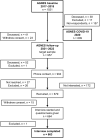Longitudinal changes in life-space mobility and autonomy in participation outdoors among Finnish community-dwelling older adults from pre-COVID-19 to through the pandemic
- PMID: 38558262
- PMCID: PMC10984880
- DOI: 10.1007/s40520-024-02734-6
Longitudinal changes in life-space mobility and autonomy in participation outdoors among Finnish community-dwelling older adults from pre-COVID-19 to through the pandemic
Abstract
Background: Among older people, community mobility was reduced at the beginning of the COVID-19 pandemic, but the longer-term changes are unclear.
Aims: To study lower extremity performance and car driving as predictors of changes in older adults' life-space mobility, autonomy in participation outdoors, and the risk of developing restricted life-space mobility from 2017 to 2022.
Methods: Life-space mobility (scoring range 0-120) and autonomy in participation outdoors (scoring range 0-20) were assessed in community-dwelling individuals (n = 657) in 2017-2018 (baseline age 75, 80, or 85 years), during the first wave of COVID-19 in 2020, and in 2021-2022. Lower extremity performance was assessed using the Short Physical Performance Battery, and car driving was self-reported at baseline. Data were analysed using generalized estimating equations and Cox regression.
Results: During the first wave of COVID-19 in 2020, life-space mobility decreased on average by 10.3 (SD 21.6) points and partially recovered in 2021-2022 (+ 2.7, SD 21.8). The same pattern was observed for autonomy in participation outdoors. Non-drivers and those with impaired lower extremity performance had a 2.4-to-3.6-fold adjusted risk of developing restricted life-space mobility over the follow-up period compared to drivers with intact lower extremity performance.
Conclusions: For older people, the recovery of community mobility was incomplete after the restrictions stemming from the pandemic were lifted. Older adults with impaired lower extremity performance and who did not drive were particularly vulnerable to developing restricted life-space mobility, a situation that could lead to social isolation and reduced well-being.
Keywords: Ageing; COVID-19; Driving; Mobility; Physical performance.
© 2024. The Author(s).
Conflict of interest statement
The authors have no competing interests to declare that are relevant to the content of this article.
Figures


References
-
- ECDC (2020) Coronavirus disease 2019 (COVID-19) in the EU/EEA and the UK – tenth update. ECDC - European Centre for Disease Prevention and Control. Accessed: Oct. 14, 2022. Available: https://www.ecdc.europa.eu/sites/default/files/documents/RRA-COVID19-upd...
-
- Baker PS, Bodner EV, Allman RM (2003) Measuring Life-Space Mobility in Community-Dwelling Older Adults: LIFE-SPACE MOBILITY. Journal of the American Geriatrics Society, vol. 51, no. 11: 1610–1614. 10.1046/j.1532-5415.2003.51512.x - PubMed
MeSH terms
LinkOut - more resources
Full Text Sources
Medical

